child lock BMW ACTIVE HYBRID 3 2015 F30H Owner's Manual
[x] Cancel search | Manufacturer: BMW, Model Year: 2015, Model line: ACTIVE HYBRID 3, Model: BMW ACTIVE HYBRID 3 2015 F30HPages: 251, PDF Size: 5.49 MB
Page 54 of 251
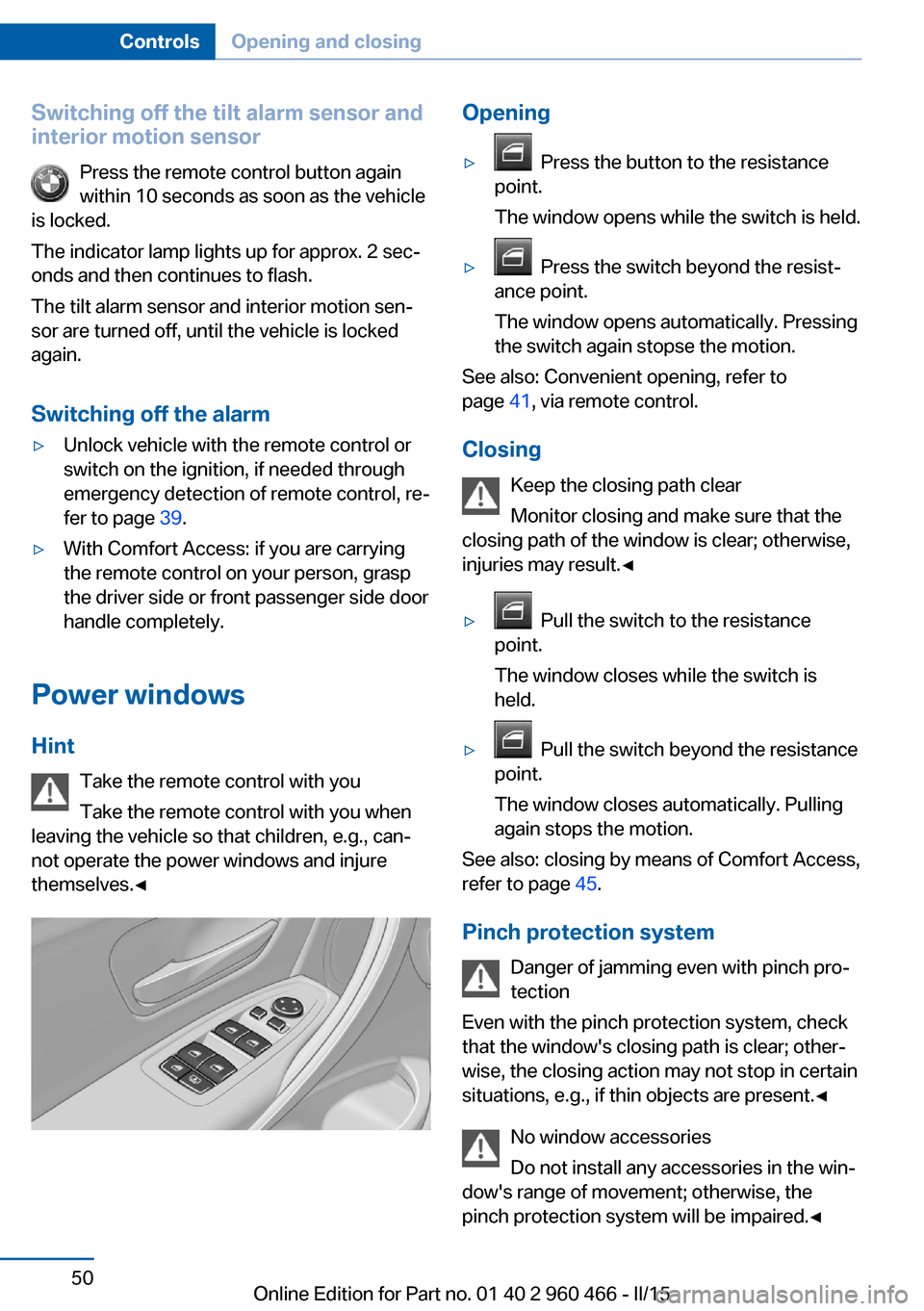
Switching off the tilt alarm sensor and
interior motion sensor
Press the remote control button again
within 10 seconds as soon as the vehicle
is locked.
The indicator lamp lights up for approx. 2 secâ
onds and then continues to flash.
The tilt alarm sensor and interior motion senâ
sor are turned off, until the vehicle is locked again.
Switching off the alarmâˇUnlock vehicle with the remote control or
switch on the ignition, if needed through
emergency detection of remote control, reâ
fer to page 39.âˇWith Comfort Access: if you are carrying
the remote control on your person, grasp
the driver side or front passenger side door
handle completely.
Power windows
Hint Take the remote control with you
Take the remote control with you when
leaving the vehicle so that children, e.g., canâ
not operate the power windows and injure
themselves.â
Opening⡠Press the button to the resistance
point.
The window opens while the switch is held.⡠Press the switch beyond the resistâ
ance point.
The window opens automatically. Pressing
the switch again stopse the motion.
See also: Convenient opening, refer to
page 41, via remote control.
Closing Keep the closing path clear
Monitor closing and make sure that the
closing path of the window is clear; otherwise,
injuries may result.â
⡠Pull the switch to the resistance
point.
The window closes while the switch is
held.⡠Pull the switch beyond the resistance
point.
The window closes automatically. Pulling
again stops the motion.
See also: closing by means of Comfort Access,
refer to page 45.
Pinch protection system Danger of jamming even with pinch proâ
tection
Even with the pinch protection system, check
that the window's closing path is clear; otherâ
wise, the closing action may not stop in certain
situations, e.g., if thin objects are present.â
No window accessories
Do not install any accessories in the winâ
dow's range of movement; otherwise, the
pinch protection system will be impaired.â
Seite 50ControlsOpening and closing50
Online Edition for Part no. 01 40 2 960 466 - II/15
Page 55 of 251
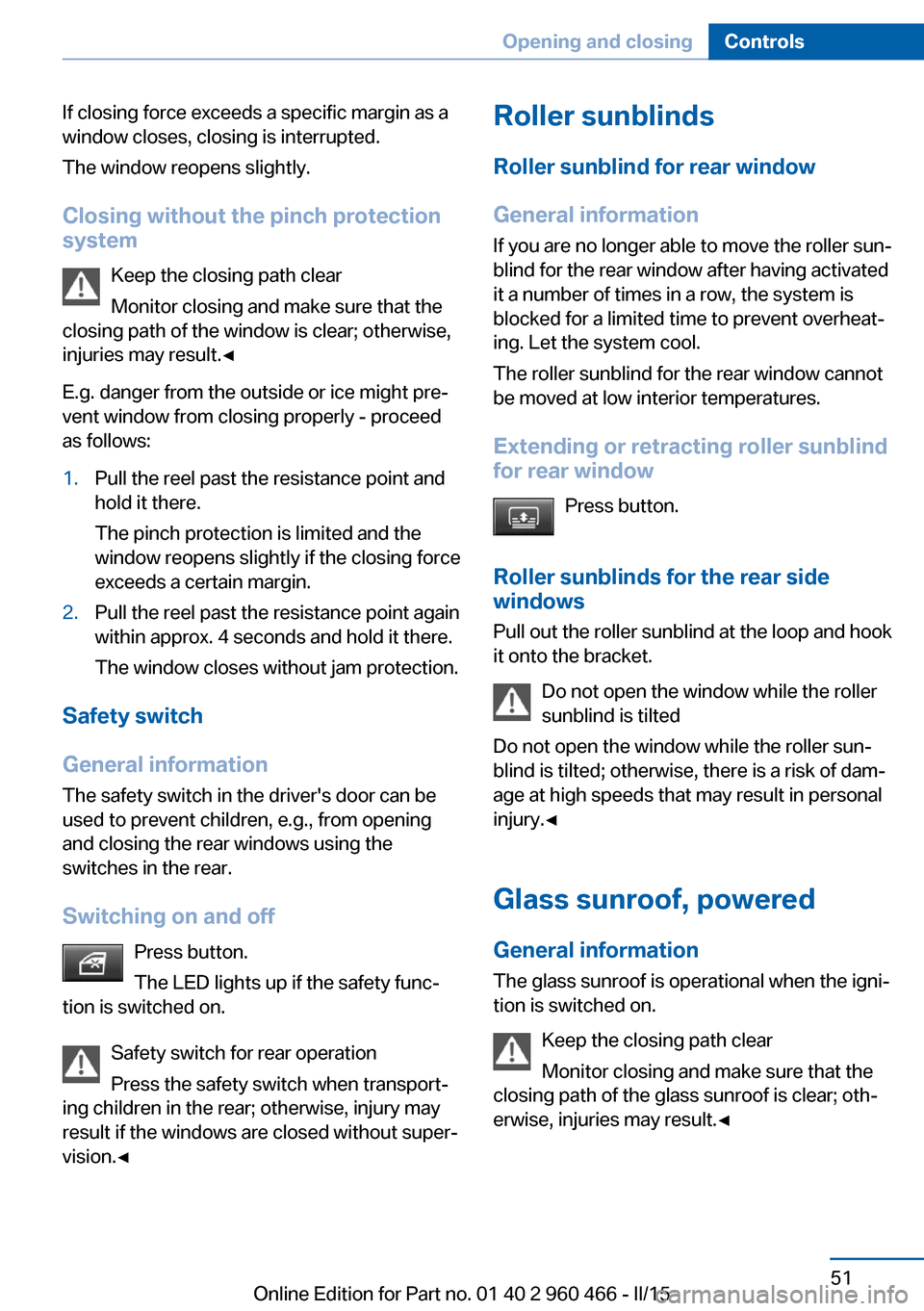
If closing force exceeds a specific margin as a
window closes, closing is interrupted.
The window reopens slightly.
Closing without the pinch protection
system
Keep the closing path clear
Monitor closing and make sure that the
closing path of the window is clear; otherwise,
injuries may result.â
E.g. danger from the outside or ice might preâ
vent window from closing properly - proceed
as follows:1.Pull the reel past the resistance point and
hold it there.
The pinch protection is limited and the
window reopens slightly if the closing force
exceeds a certain margin.2.Pull the reel past the resistance point again
within approx. 4 seconds and hold it there.
The window closes without jam protection.
Safety switch
General information
The safety switch in the driver's door can be
used to prevent children, e.g., from opening
and closing the rear windows using the
switches in the rear.
Switching on and off Press button.
The LED lights up if the safety funcâ
tion is switched on.
Safety switch for rear operationPress the safety switch when transportâ
ing children in the rear; otherwise, injury may
result if the windows are closed without superâ
vision.â
Roller sunblinds
Roller sunblind for rear window
General information If you are no longer able to move the roller sunâ
blind for the rear window after having activated
it a number of times in a row, the system is
blocked for a limited time to prevent overheatâ ing. Let the system cool.
The roller sunblind for the rear window cannot
be moved at low interior temperatures.
Extending or retracting roller sunblind for rear window
Press button.
Roller sunblinds for the rear side
windows
Pull out the roller sunblind at the loop and hook
it onto the bracket.
Do not open the window while the roller
sunblind is tilted
Do not open the window while the roller sunâ
blind is tilted; otherwise, there is a risk of damâ
age at high speeds that may result in personal
injury.â
Glass sunroof, poweredGeneral information
The glass sunroof is operational when the igniâ
tion is switched on.
Keep the closing path clear
Monitor closing and make sure that the
closing path of the glass sunroof is clear; othâ
erwise, injuries may result.âSeite 51Opening and closingControls51
Online Edition for Part no. 01 40 2 960 466 - II/15
Page 61 of 251

Front seat heating
Switching onPress button once for each temperaâ
ture level.
The maximum temperature is reached when
three LEDs are lit.
If the journey is continued within approx. 15
minutes, the seat heating is activated automatâ
ically with the temperature selected last.
When ECO PRO, refer to page 181, is actiâ
vated, the heater output is reduced.
Switch off Press button longer.
The LEDs go out.
Rear seat heating
Switching on Press button once for each temperaâ
ture level.
The maximum temperature is reached when
three LEDs are lit.
If the journey is continued within approx. 15
minutes, the seat heating is activated automatâ
ically with the temperature selected last.
When ECO PRO, refer to page 181, is actiâ
vated, the heater output is reduced.
Switch off Press button longer.
The LEDs go out.
Safety belts
Seats with safety belt The vehicle has five seats, each of which is
equipped with a safety belt.
General information
Always make sure that safety belts are being
worn by all occupants before driving off.
For the occupants' safety the belt locking
mechanism triggers early. Slowly guide the
belt out of the holder when applying it.
Although airbags enhance safety by providing
added protection, they are not a substitute for
safety belts.
The upper shoulder strap's anchorage point
will be correct for adult seat occupants of evâ
ery build if the seat is correctly adjusted.âˇThe two outer safety belt buckles,
integrated into the rear seat, are for pasâ
sengers sitting on the left and right.âˇThe center rear safety belt buckle is solely
intended for the center passenger.
Hints
One person per safety belt
Never allow more than one person to
wear a single safety belt. Never allow infants or
small children to ride on a passenger's lap.â
Seite 57AdjustingControls57
Online Edition for Part no. 01 40 2 960 466 - II/15
Page 68 of 251
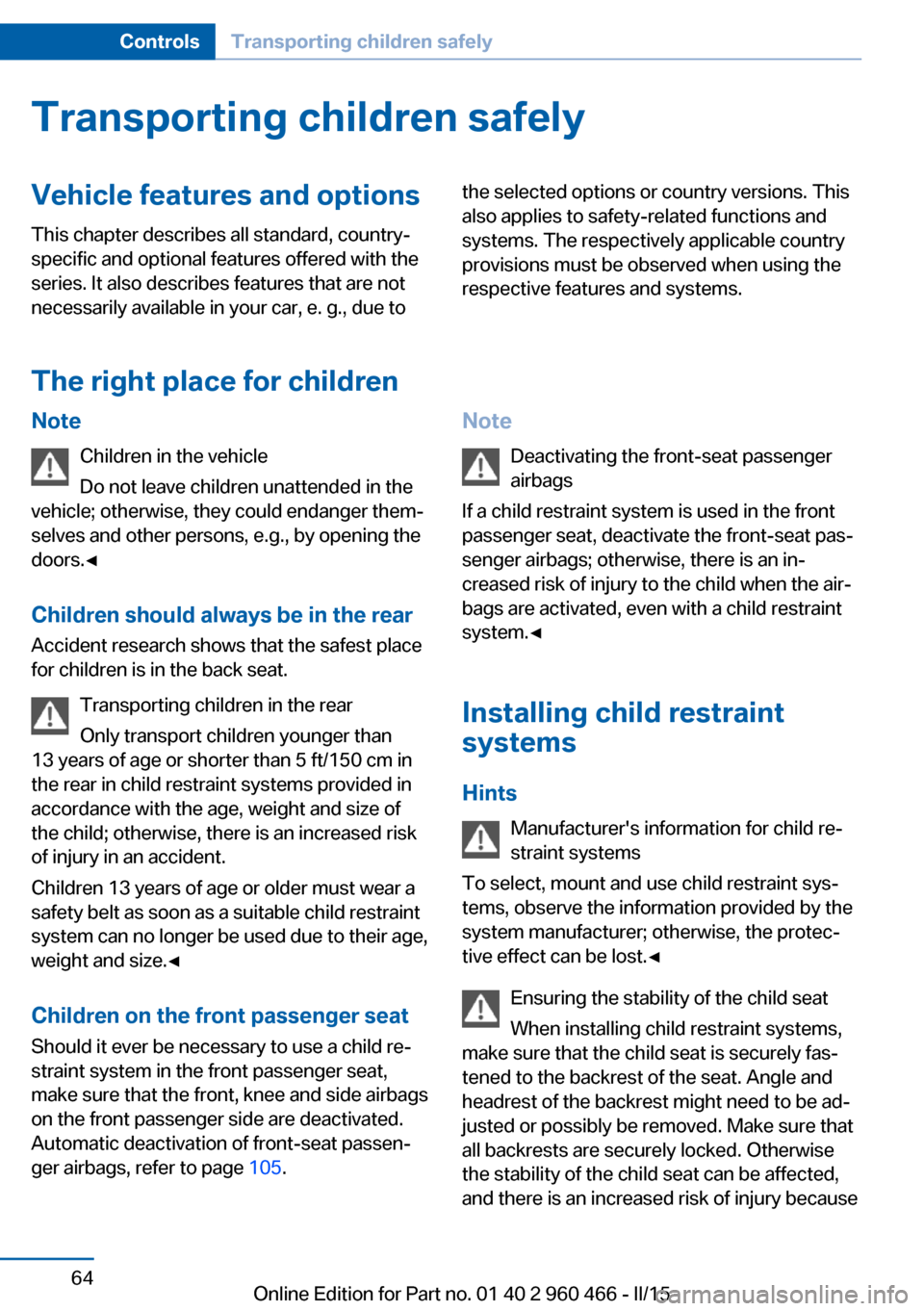
Transporting children safelyVehicle features and optionsThis chapter describes all standard, country-
specific and optional features offered with the
series. It also describes features that are not
necessarily available in your car, e. g., due tothe selected options or country versions. This
also applies to safety-related functions and
systems. The respectively applicable country
provisions must be observed when using the
respective features and systems.
The right place for children
Note
Children in the vehicle
Do not leave children unattended in the
vehicle; otherwise, they could endanger themâ
selves and other persons, e.g., by opening the
doors.â
Children should always be in the rear Accident research shows that the safest place
for children is in the back seat.
Transporting children in the rear
Only transport children younger than
13 years of age or shorter than 5 ft/150 cm in
the rear in child restraint systems provided in
accordance with the age, weight and size of
the child; otherwise, there is an increased risk
of injury in an accident.
Children 13 years of age or older must wear a
safety belt as soon as a suitable child restraint
system can no longer be used due to their age,
weight and size.â
Children on the front passenger seat
Should it ever be necessary to use a child reâ
straint system in the front passenger seat,
make sure that the front, knee and side airbags
on the front passenger side are deactivated.
Automatic deactivation of front-seat passenâ
ger airbags, refer to page 105.Note
Deactivating the front-seat passenger
airbags
If a child restraint system is used in the front
passenger seat, deactivate the front-seat pasâ
senger airbags; otherwise, there is an inâ
creased risk of injury to the child when the airâ
bags are activated, even with a child restraint
system.â
Installing child restraint
systems
Hints Manufacturer's information for child reâstraint systems
To select, mount and use child restraint sysâ
tems, observe the information provided by the
system manufacturer; otherwise, the protecâ
tive effect can be lost.â
Ensuring the stability of the child seat
When installing child restraint systems,
make sure that the child seat is securely fasâ
tened to the backrest of the seat. Angle and
headrest of the backrest might need to be adâ
justed or possibly be removed. Make sure that
all backrests are securely locked. Otherwise
the stability of the child seat can be affected,
and there is an increased risk of injury becauseSeite 64ControlsTransporting children safely64
Online Edition for Part no. 01 40 2 960 466 - II/15
Page 69 of 251
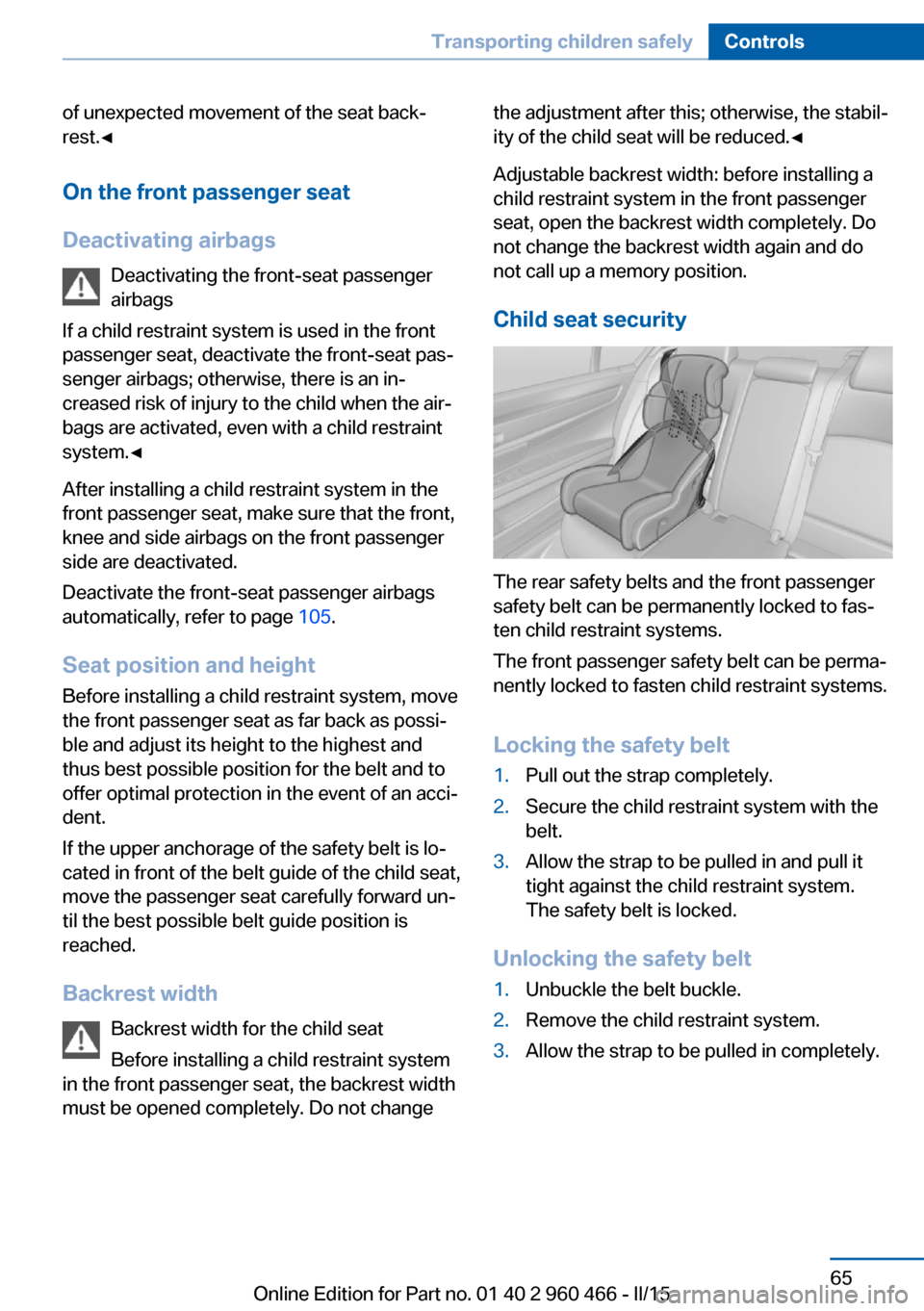
of unexpected movement of the seat backâ
rest.â
On the front passenger seat
Deactivating airbags Deactivating the front-seat passenger
airbags
If a child restraint system is used in the front
passenger seat, deactivate the front-seat pasâ
senger airbags; otherwise, there is an inâ
creased risk of injury to the child when the airâ
bags are activated, even with a child restraint
system.â
After installing a child restraint system in the
front passenger seat, make sure that the front,
knee and side airbags on the front passenger
side are deactivated.
Deactivate the front-seat passenger airbags automatically, refer to page 105.
Seat position and height
Before installing a child restraint system, move
the front passenger seat as far back as possiâ
ble and adjust its height to the highest and
thus best possible position for the belt and to
offer optimal protection in the event of an acciâ
dent.
If the upper anchorage of the safety belt is loâ
cated in front of the belt guide of the child seat,
move the passenger seat carefully forward unâ
til the best possible belt guide position is
reached.
Backrest width Backrest width for the child seat
Before installing a child restraint system
in the front passenger seat, the backrest width
must be opened completely. Do not changethe adjustment after this; otherwise, the stabilâ
ity of the child seat will be reduced.â
Adjustable backrest width: before installing a
child restraint system in the front passenger
seat, open the backrest width completely. Do
not change the backrest width again and do
not call up a memory position.
Child seat security
The rear safety belts and the front passenger
safety belt can be permanently locked to fasâ
ten child restraint systems.
The front passenger safety belt can be permaâ
nently locked to fasten child restraint systems.
Locking the safety belt
1.Pull out the strap completely.2.Secure the child restraint system with the
belt.3.Allow the strap to be pulled in and pull it
tight against the child restraint system.
The safety belt is locked.
Unlocking the safety belt
1.Unbuckle the belt buckle.2.Remove the child restraint system.3.Allow the strap to be pulled in completely.Seite 65Transporting children safelyControls65
Online Edition for Part no. 01 40 2 960 466 - II/15
Page 71 of 251
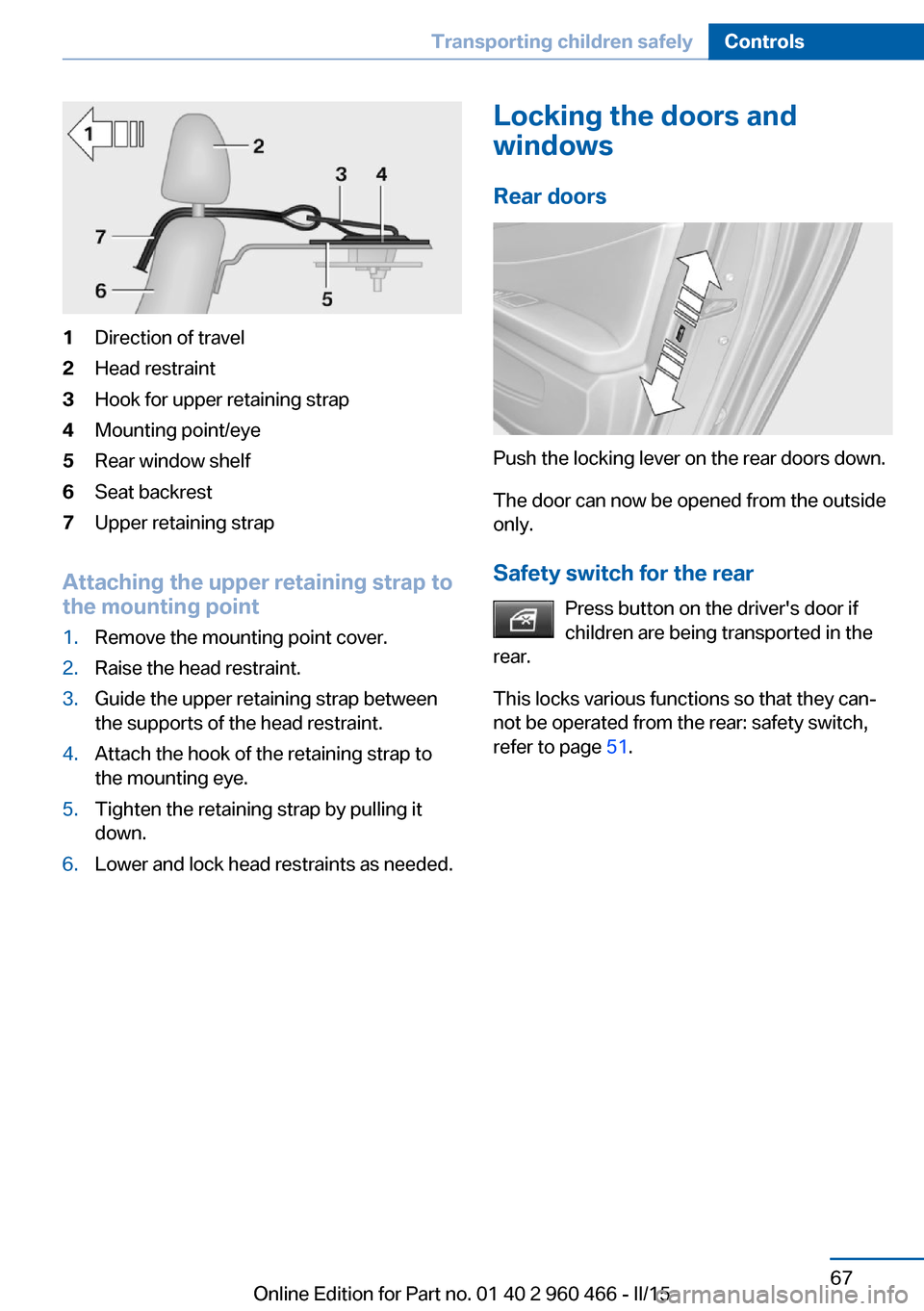
1Direction of travel2Head restraint3Hook for upper retaining strap4Mounting point/eye5Rear window shelf6Seat backrest7Upper retaining strap
Attaching the upper retaining strap to
the mounting point
1.Remove the mounting point cover.2.Raise the head restraint.3.Guide the upper retaining strap between
the supports of the head restraint.4.Attach the hook of the retaining strap to
the mounting eye.5.Tighten the retaining strap by pulling it
down.6.Lower and lock head restraints as needed.Locking the doors and
windows
Rear doors
Push the locking lever on the rear doors down.
The door can now be opened from the outside
only.
Safety switch for the rear Press button on the driver's door if
children are being transported in the
rear.
This locks various functions so that they canâ
not be operated from the rear: safety switch,
refer to page 51.
Seite 67Transporting children safelyControls67
Online Edition for Part no. 01 40 2 960 466 - II/15
Page 73 of 251
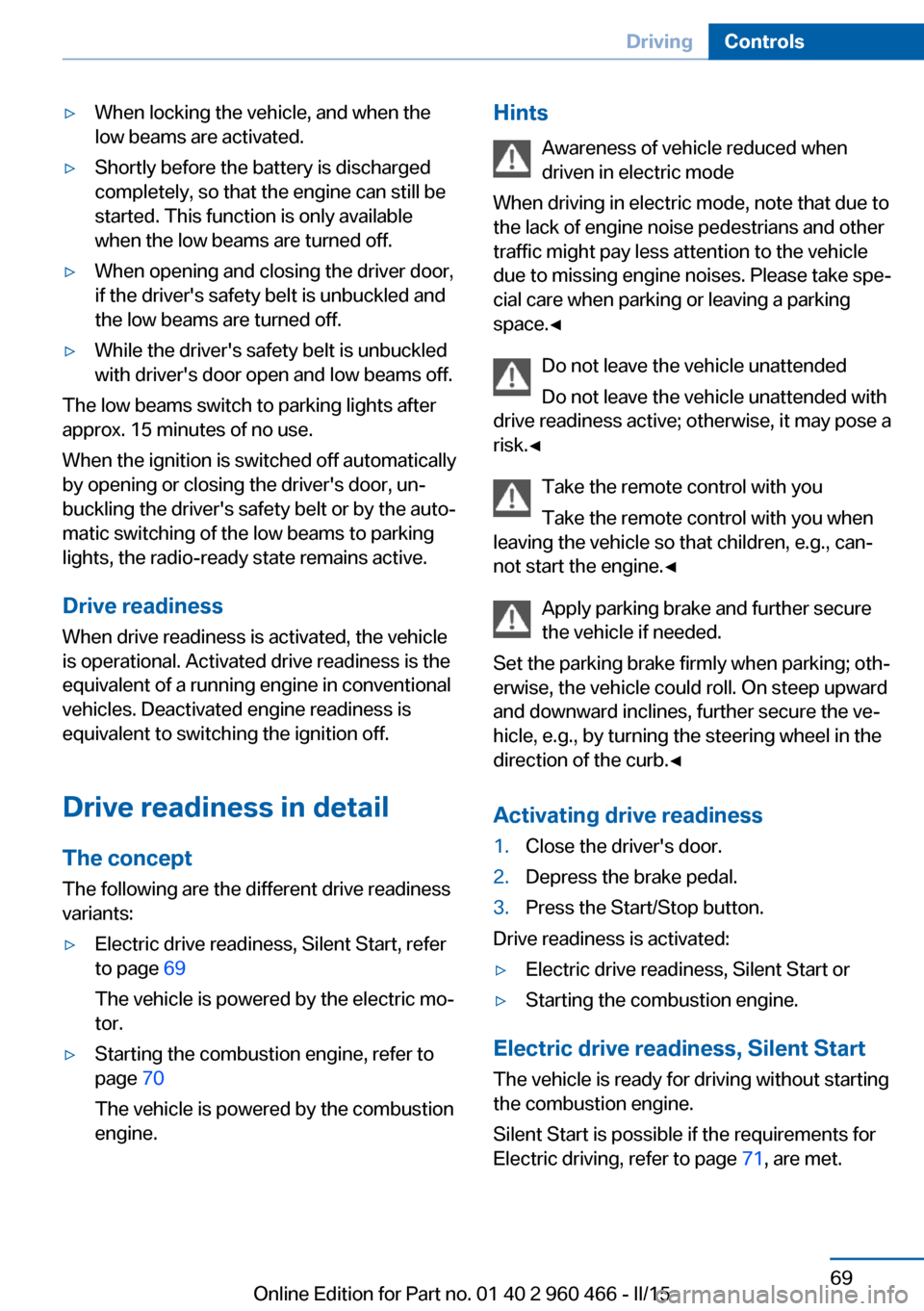
âˇWhen locking the vehicle, and when the
low beams are activated.âˇShortly before the battery is discharged
completely, so that the engine can still be
started. This function is only available
when the low beams are turned off.âˇWhen opening and closing the driver door,
if the driver's safety belt is unbuckled and
the low beams are turned off.âˇWhile the driver's safety belt is unbuckled
with driver's door open and low beams off.
The low beams switch to parking lights after
approx. 15 minutes of no use.
When the ignition is switched off automatically
by opening or closing the driver's door, unâ
buckling the driver's safety belt or by the autoâ
matic switching of the low beams to parking
lights, the radio-ready state remains active.
Drive readiness
When drive readiness is activated, the vehicle
is operational. Activated drive readiness is the
equivalent of a running engine in conventional
vehicles. Deactivated engine readiness is
equivalent to switching the ignition off.
Drive readiness in detail
The concept
The following are the different drive readiness
variants:
âˇElectric drive readiness, Silent Start, refer
to page 69
The vehicle is powered by the electric moâ
tor.âˇStarting the combustion engine, refer to
page 70
The vehicle is powered by the combustion
engine.Hints
Awareness of vehicle reduced when
driven in electric mode
When driving in electric mode, note that due to
the lack of engine noise pedestrians and other traffic might pay less attention to the vehicle
due to missing engine noises. Please take speâ
cial care when parking or leaving a parking
space.â
Do not leave the vehicle unattended
Do not leave the vehicle unattended with
drive readiness active; otherwise, it may pose a
risk.â
Take the remote control with you
Take the remote control with you when
leaving the vehicle so that children, e.g., canâ
not start the engine.â
Apply parking brake and further secure
the vehicle if needed.
Set the parking brake firmly when parking; othâ
erwise, the vehicle could roll. On steep upward
and downward inclines, further secure the veâ
hicle, e.g., by turning the steering wheel in the
direction of the curb.â
Activating drive readiness1.Close the driver's door.2.Depress the brake pedal.3.Press the Start/Stop button.
Drive readiness is activated:
âˇElectric drive readiness, Silent Start orâˇStarting the combustion engine.
Electric drive readiness, Silent Start The vehicle is ready for driving without starting
the combustion engine.
Silent Start is possible if the requirements for
Electric driving, refer to page 71, are met.
Seite 69DrivingControls69
Online Edition for Part no. 01 40 2 960 466 - II/15
Page 167 of 251
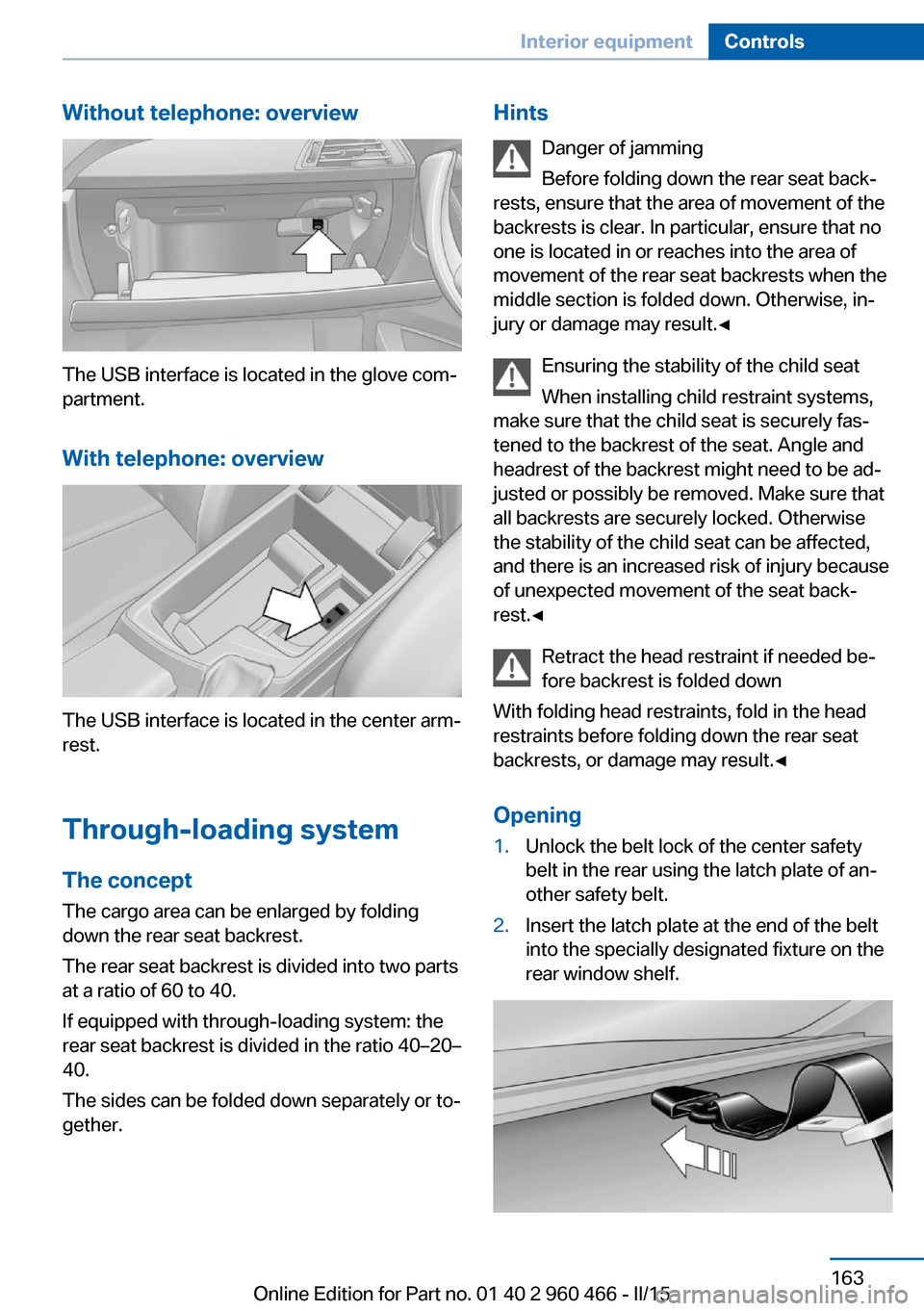
Without telephone: overview
The USB interface is located in the glove comâ
partment.
With telephone: overview
The USB interface is located in the center armâ
rest.
Through-loading system The concept The cargo area can be enlarged by folding
down the rear seat backrest.
The rear seat backrest is divided into two parts at a ratio of 60 to 40.
If equipped with through-loading system: the
rear seat backrest is divided in the ratio 40â20â
40.
The sides can be folded down separately or toâ
gether.
Hints
Danger of jamming
Before folding down the rear seat backâ
rests, ensure that the area of movement of the
backrests is clear. In particular, ensure that no
one is located in or reaches into the area of
movement of the rear seat backrests when the
middle section is folded down. Otherwise, inâ
jury or damage may result.â
Ensuring the stability of the child seat
When installing child restraint systems,
make sure that the child seat is securely fasâ
tened to the backrest of the seat. Angle and
headrest of the backrest might need to be adâ
justed or possibly be removed. Make sure that
all backrests are securely locked. Otherwise the stability of the child seat can be affected,
and there is an increased risk of injury because
of unexpected movement of the seat backâ rest.â
Retract the head restraint if needed beâ
fore backrest is folded down
With folding head restraints, fold in the head
restraints before folding down the rear seat
backrests, or damage may result.â
Opening1.Unlock the belt lock of the center safety
belt in the rear using the latch plate of anâ
other safety belt.2.Insert the latch plate at the end of the belt
into the specially designated fixture on the
rear window shelf.Seite 163Interior equipmentControls163
Online Edition for Part no. 01 40 2 960 466 - II/15
Page 241 of 251

tertainment and Communiâ
cation
BMW Driverâs Guide App 6
BMW Homepage 6
BMW Internet page 6
BMW maintenance sysâ tem 209
Bonus range, ECO PRO 182
Bottle holder, refer to Cuâ pholders 167
Brake assistant 125
Brake discs, break-in 172
Brake force display 124
Brake lights, adaptive 124
Brake lights, brake force disâ play 124
Brake pads, break-in 172
Braking, hints 175
Breakdown assistance 222
Break-in 172
Brightness of Control Disâ play 96
Bulb replacement 211
Bulb replacement, front 212
Bulb replacement, halogen headlights 212
Bulb replacement, rear 217
Bulb replacement, xenon headlights 215
Bulbs and lights 211
Button, RES 133
Button, Start/Stop 68
Bypassing, refer to Jump- starting 223
C
California Proposition 65 Warning 8
Camera lenses, care 231
Camera, rearview camâ era 141
Camera, Side View 144
Camera, Top View 145
Can holder, refer to Cupholdâ ers 167 Car battery 220
Car care products 229
Care, displays 231
Care, vehicle 229
Cargo 177
Cargo area, enlarging 163
Cargo area, storage compartâ ments 167
Cargo, securing 178
Cargo straps, securing cargo 178
Car key, refer to Remote conâ trol 38
Carpet, care 231
Car wash 228
Catalytic converter, refer to Hot exhaust system 174
CBS Condition Based Servâ ice 209
CD/Multimedia, see user's manual for Navigation, Enâ
tertainment and Communiâ
cation
Center armrest 166
Center console 16
Central locking system 43
Central screen, refer to Conâ trol Display 18
Changes, technical, refer to Safety 7
Changing parts 211
Changing wheels 219
Changing wheels/tires 197
CHARGE, energy recovâ ery 72
Charge indicator, high-voltâ age battery 82
Chassis number, see vehicle identification number 10
Check Control 84
Checking the engine oil level electronically 205
Checking the oil level elecâ tronically 205
Children, seating position 64 Children, transporting
safely 64
Child restraint fixing sysâ tem 64
Child restraint fixing system LATCH 66
Child restraint fixing systems, mounting 64
Child safety locks 67
Child seat, mounting 64
Child seats 64
Chrome parts, care 230
Cigarette lighter 161
Cleaning displays 231
Climate control 151
Clock 88
Closing/opening via door lock 43
Closing/opening with remote control 41
Clothes hooks 167
Coasting 71
Cockpit 14
Combination reel, refer to Turn signals 73
Combination switch, refer to Wiper system 74
Combustion engine, startâ ing 70
Comfort Access 45
COMFORT program, Dyâ namic Driving Control 128
Compartments in the doors 166
Compass 159
Compressor 198
Computer, refer to On-board computer 92
Condensation on winâ dows 153
Condensation under the vehiâ cle 176
Condition Based Service CBS 209
Confirmation signal 48 Seite 237Everything from A to ZReference237
Online Edition for Part no. 01 40 2 960 466 - II/15
Page 245 of 251
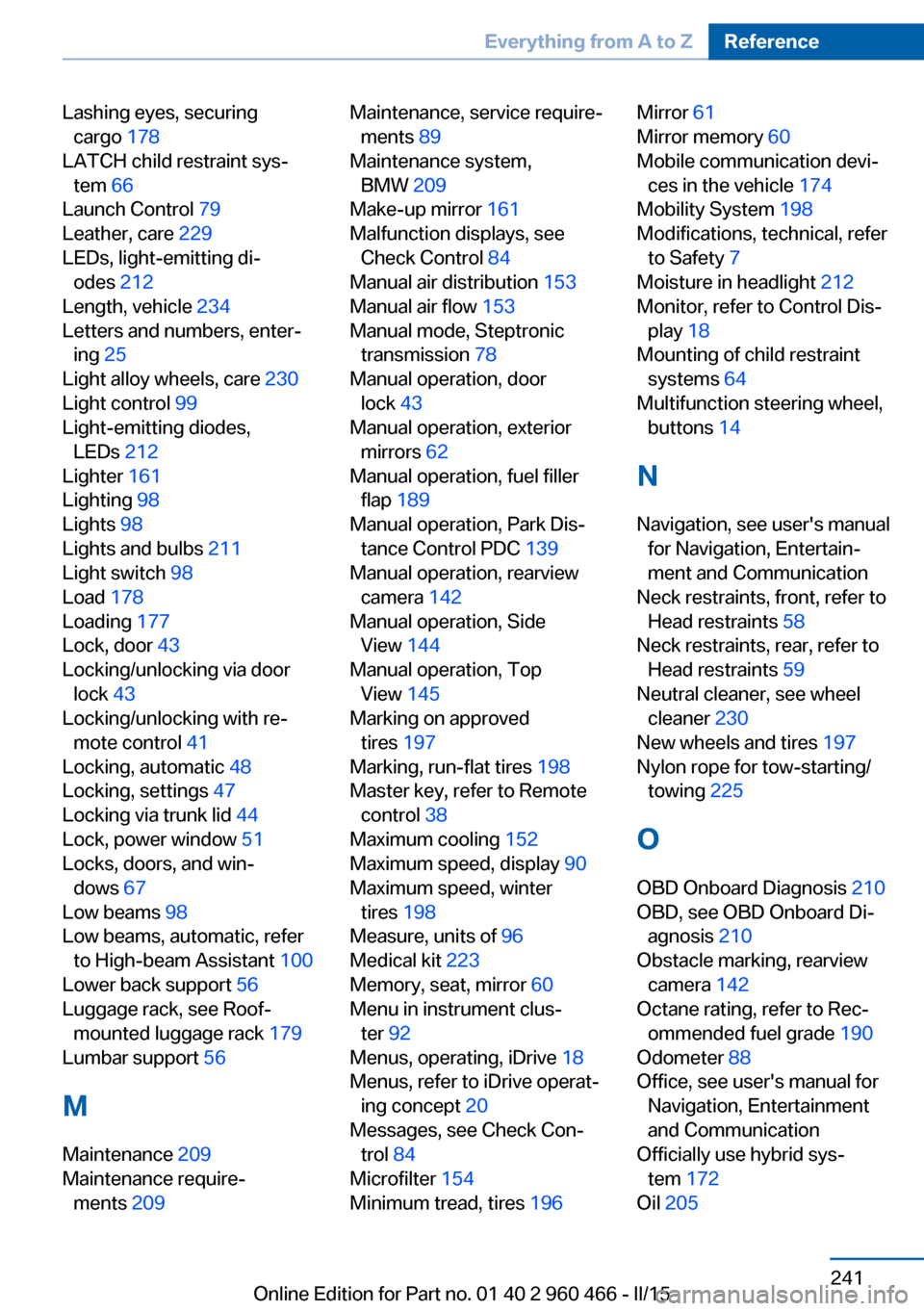
Lashing eyes, securingcargo 178
LATCH child restraint sysâ tem 66
Launch Control 79
Leather, care 229
LEDs, light-emitting diâ odes 212
Length, vehicle 234
Letters and numbers, enterâ ing 25
Light alloy wheels, care 230
Light control 99
Light-emitting diodes, LEDs 212
Lighter 161
Lighting 98
Lights 98
Lights and bulbs 211
Light switch 98
Load 178
Loading 177
Lock, door 43
Locking/unlocking via door lock 43
Locking/unlocking with reâ mote control 41
Locking, automatic 48
Locking, settings 47
Locking via trunk lid 44
Lock, power window 51
Locks, doors, and winâ dows 67
Low beams 98
Low beams, automatic, refer to High-beam Assistant 100
Lower back support 56
Luggage rack, see Roof- mounted luggage rack 179
Lumbar support 56
M
Maintenance 209
Maintenance requireâ ments 209 Maintenance, service requireâ
ments 89
Maintenance system, BMW 209
Make-up mirror 161
Malfunction displays, see Check Control 84
Manual air distribution 153
Manual air flow 153
Manual mode, Steptronic transmission 78
Manual operation, door lock 43
Manual operation, exterior mirrors 62
Manual operation, fuel filler flap 189
Manual operation, Park Disâ tance Control PDC 139
Manual operation, rearview camera 142
Manual operation, Side View 144
Manual operation, Top View 145
Marking on approved tires 197
Marking, run-flat tires 198
Master key, refer to Remote control 38
Maximum cooling 152
Maximum speed, display 90
Maximum speed, winter tires 198
Measure, units of 96
Medical kit 223
Memory, seat, mirror 60
Menu in instrument clusâ ter 92
Menus, operating, iDrive 18
Menus, refer to iDrive operatâ ing concept 20
Messages, see Check Conâ trol 84
Microfilter 154
Minimum tread, tires 196 Mirror 61
Mirror memory 60
Mobile communication deviâ ces in the vehicle 174
Mobility System 198
Modifications, technical, refer to Safety 7
Moisture in headlight 212
Monitor, refer to Control Disâ play 18
Mounting of child restraint systems 64
Multifunction steering wheel, buttons 14
N Navigation, see user's manual for Navigation, Entertainâ
ment and Communication
Neck restraints, front, refer to Head restraints 58
Neck restraints, rear, refer to Head restraints 59
Neutral cleaner, see wheel cleaner 230
New wheels and tires 197
Nylon rope for tow-starting/ towing 225
O OBD Onboard Diagnosis 210
OBD, see OBD Onboard Diâ agnosis 210
Obstacle marking, rearview camera 142
Octane rating, refer to Recâ ommended fuel grade 190
Odometer 88
Office, see user's manual for Navigation, Entertainment
and Communication
Officially use hybrid sysâ tem 172
Oil 205 Seite 241Everything from A to ZReference241
Online Edition for Part no. 01 40 2 960 466 - II/15